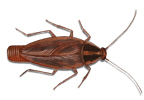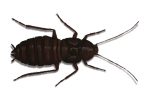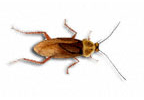German Cockroach
Blatella germanica
The German cockroach is very successful at establishing an ecological niche in buildings, and is very hardy and resilient against attempts at pest control. This is because of the large number of nymphs produced from each egg case, the short period between birth and sexual maturity, and their ability to easily hide due to their small size. The mother also carries the egg case (called an ootheca) with her during the germination period, rather than depositing it like other species, a practice which would leave them vulnerable in a human habitat to zealous attempts to wipe them out. This cockroach is also smaller than many other species so it can more easily hide and fit into very small cracks and crevices to evade humans.
Appearance

• 12 – 15mm long.
• Brown with 2 dark stripes on thorax.
• The wings are as long as the body or slightly overlapping in both sexes..
• Runs and climbs (sticky pads on the feet)..
Lifecycle
• Females carry 35 - 40 eggs in an ootheca (egg case) until they are ready to hatch.
• Hatch in 1 month.
• Nymphs take between 6 weeks to 6 months to develop into adults.
Habits
• Heated buildings, often kitchens and ships. Prefers high temperatures and humidities.
• Nocturnal.
• Will eat around 3g of food a day and can survive without any additional water. They will drink up to 3ml a day if their diet is particularly dry.
• Omnivorous.
Common or Oriental Cockroach
Blatta orientalis
The oriental cockroach (also known as: waterbug and Blatta orientalis) is a large species of cockroach, measuring about in length at maturity. It is dark brown to black in colour and has a glossy body. The female Oriental cockroach has a somewhat different appearance to the male, appearing to be wingless at casual glance but has two very short and useless wings just below its head. It has a wider body than the male. The oriental cockroach tends to travel somewhat more slowly than other species. They are often called "waterbugs" since they prefer dark, moist places. They can often be found around decaying organic matter, and in sewers, drains, damp basements, porches, and other damp locations. They can be found outside in bushes, under leaf groundcover, under mulch, and around other damp places outdoors.
Appearance

• 25 – 30 mm long.
• Dark brown to black in colour.
• The wings undeveloped in female and cover ¾ length of the abdomen in the male..
• Runs rather than flies..
Lifecycle
• Females deposit 16 eggs in an ootheca (egg case).
• Hatch in 2 months.
• Nymphs take 5 – 9 months to develop into adults.
Habits
• Buildings. Can tolerate lower temperatures than other cockroaches so can also be found outdoors, on rubbish tips etc.
• Nocturnal.
• Omnivorous.
American Cockroach
Periplaneta americana
The American cockroach (Periplaneta americana), also known as the Palmetto Bug or Waterbug, particularly in thesouthern United States, is the largest species of common cockroach, and often considered a pest.
American cockroach adults grow to an average length of around and about tall. They are reddish brown and have a yellowish margin on the body region behind the head. Immature cockroaches resemble adults except that they are wingless.
The insect can travel quickly, often darting out of sight when someone enters a room, and can fit into small cracks and under doors despite its fairly large size. It is considered one of the fastest running insects.
Appearance

• 28 – 44 mm long.
• Shining red–brown in colour.
• Wings longer than the body in male; only just overlap abdomen in female..
• Runs (may fly at very high temperatures)..
Lifecycle
• The ootheca (egg case) containing 6 – 28 eggs is carried by the female for several days before being deposited. Sometimes cemented down and tend to be grouped.
• Hatch in 1 – 2 months.
• Nymphs usually develop in 5 months, but it can take up to 15 months.
Habits
• Principally inside buildings, drains, basements, pipe ducts and risers.
• Nocturnal.
• Omnivorous.


